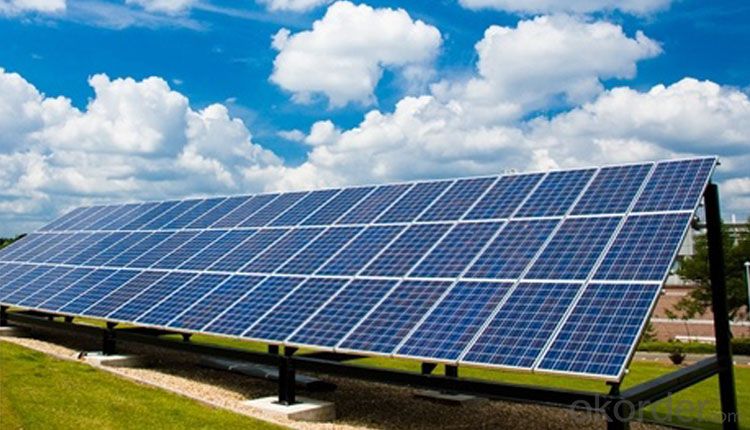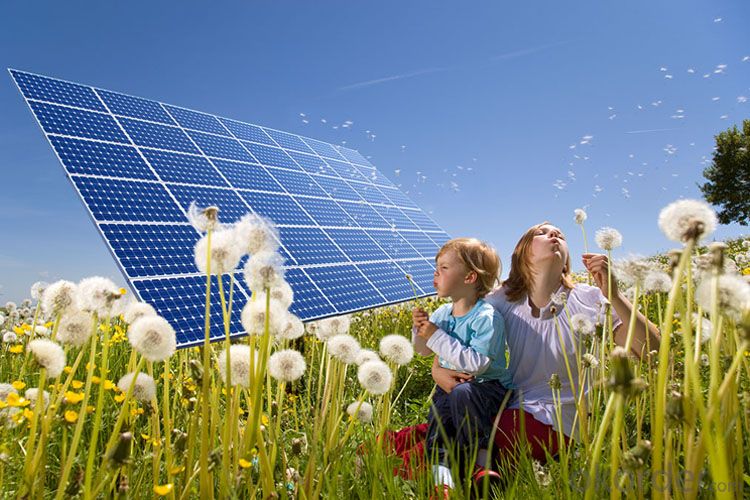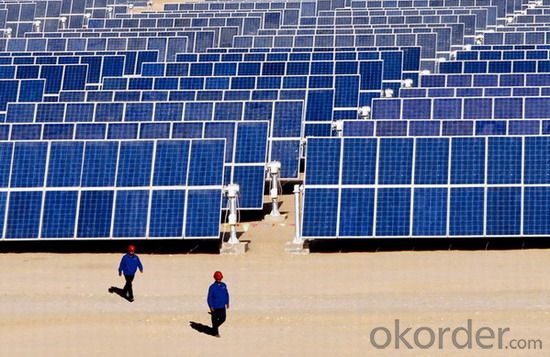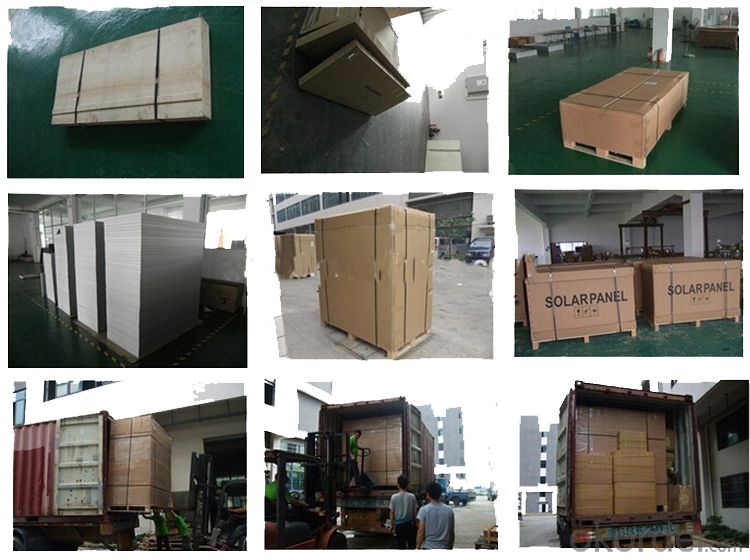CE and TUV Approved 10W Poly Solar Panel
- Loading Port:
- Shanghai
- Payment Terms:
- TT OR LC
- Min Order Qty:
- 10000 watt
- Supply Capability:
- 20000000 watt/month
OKorder Service Pledge
OKorder Financial Service
You Might Also Like
Item specifice
1. The Introduction of Solar Module
Solar modules use light energy from the sun to generate electricity through the photovoltaic effect. The majority of modules use wafer-based crystalline silicon cells or thin-film cells based on cadmium telluride or silicon. The structural (load carrying) member of a module can either be the top layer or the back layer. Cells must also be protected from mechanical damage and moisture. Most solar modules are rigid, but semi-flexible ones are available, based on thin-film cells.
2.Technical Parameter
Type | CNBM Solar Polycrystalline Series |
Materials | Silicon |
Guarantee | 12 yrs free from defects in materials and workmanship No less than 90% within 10yrs and no less than 80% within 25yrs TUV(IEC61215&IEC61730), CE, UL |
Application | Photovoltaic/ solar/ green energy/ energy saving |
Descriptions | 1.High efficiency crystalline silicon solar cell. Even if under the weak light, the solar module can produce maximum power output. 2.Tempered glass (toughened glass): Anti-reflecting coating and high transmission rate glass increase the power output and mechanical strength of solar module. 3. EVA and TPT: Using high quality EVA and TPT to prevent destroying and water. 4. AI frame: Without screw, rner connection. 6 holes on the frame can be installed easily. 5. Junction box: Multi function junction box with water proof. 6. Long lifetime: ≥25 years; Less power decrease. 7. Good performance of preventing from atrocious weather such as wind and hails. 8. Resisting moisture and etching effectively, not effected by geology. 9. The certificate issued by international authority: UL, TUV, IEC, CE.
|
Packaging Details: | 26pcs/pallet, 28pallets/ 40HQ Our solar panels are packed in cartons, and then pallet. Shipping by sea or by air are both ok, it up to customer’s chose. We’d like to inquiry the freight cost for customer after be informed exact quantity and destination address. |
3. Application and Pictures of Products



4. How to Work

5. Packing Details

6. FAQ
Q1: What is the business type for the company?
A1: We are one of the biggest manufacturers in zhejiang.Chnia. Which is a high tech PV enterprise dedicated to the research, development, production and sales..
Q2: How long solar panel warranty can you offer?
A2: 10-Year product warranty,25-year linear power output warranty
If there is any quality problem, we will pay for freight and send free parts to you.
Q3: How many certificates do you have?
A3: We have 16 certificates,such as CE, TUV, UL, and so on.
- Q:If I put a 5000 watt solar panel kit on my roof in Dublin (Ireland) - how much electricity would I realistically expect to get?An educated guess at a percentage of 5000w would do.
- Note that aiming is important - the sun is going to be perpendicular to the panels for only a few hours a year unless they are on an adjustable mount, so picking the time you most want power should be a factor in the angle they are mounted at - you can't keep the highest level of sun for summer into the winter time when the sun is much lower in the sky for a shorter time.
- Q:Can solar panels be installed in areas with high seismic activity?
- Yes, solar panels can be installed in areas with high seismic activity. However, it is crucial to design and install the solar panel systems in a manner that accounts for the seismic risks. This involves using appropriate mounting and anchoring techniques to ensure the panels remain secure during earthquakes or tremors. Additionally, conducting a thorough structural analysis and adhering to local building codes and regulations can further enhance the safety and stability of the solar panel installations in such areas.
- Q:Is there any way to charge my laptop with a solar panel? Is there any panel like that. Or if I work on panels can I do something like that. If you know anything about it, can you just help me? Thanks a lot.
- A solar panel is usually 36 cells and intended to charge a 2V lead acid battery. The battery in laptops may be somewhere between 5 and 20V. The panel might charge a laptop when it is cold, but they heat up in the sun and then it would no longer charge. Typical lap top power supplies are 3 to 4 amps. You need 2 panels in series to get enough voltage to charge the battery directly, but this is wasteful. If you want to charge at the same rate as a lap top power supply you need large panels to provide 5 amps. The 5 Amp panel will only give 5A when pointed directly at the full sun. There may be between 2 and 5 hours a day equivalent full sun depending where you are, time of year. If you want more than that, you need larger panels, or more than one in parallel for a 2V system. It makes sense to charge a 2V battery with the solar panel, and use that to operate the lap top with a car type power supply for a laptop, which runs from a 2V battery (see link below for an example). Get the biggest panel you can afford, and the battery should be larger if you want to run the lap top when the sun isn't shining. Perhaps a 20AH battery is a minimum size. All this costs more than a lap top.
- Q:Didnt solar panels use to cost around $250,000 5 years ago?
- For just 5 years ago, certainly not! Perhaps you are thinking of 50 years ago, the kind that was put on the early communication satellites? 5 years ago, there was a glut of polysilicon, so modules were actually a little cheaper than today. Solar cell makers were basically using the scraps thrown away by chipmakers. But today, more silicon goes into making solar cells than computer chips, so that bonanza is gone. We will see prices going lower this year, possibly 20% from last year, because of improvements in technology, but also an increase in polysilicon supply, and a slowdown in demand due to worldwide recession. Later this year is a good time to buy panels, if you have the cash. The industry site below tracks module prices. They used to have more data, but I guess the old data rolls off the screen with time. If you want to see the details, they'll charge you for the report.
- Q:want to run 400 watt heater 8 hrs a day how many solar panels do i need and batteries
- You could do that, but it would be an expensive way to go. If what you really want is heat, consider heating water directly with conventional solar water heaters, and storing it in a large, insulated tank. You can then circulate the water through a conventional radiator at night.
- Q:Hi, I bought 50 6X6 inch solar cells, I also bought a 40 amp diode, I still need to buy a battery, and inverter and a voltage controller, could you tell answer me the following questions:) I would like t build a small panel at first, (may be 0 X 0 inch), with that I would like (or at least to try) to power my laptop for the hole day, so I wont receive a very high amperage, yet, all the inverters I saw at e-bay are rated over 400 amp, if I buy a 400 amp inverter, can I use it with such a small amperage?2) what about buying a small car inverter, will it work?3) suggestion about the battery and the voltage controller will be kindly appreciated.Thanks
- I'm guessing that each of those solar cells is just 0.5 volt at max power, so if you make a 2-inch square panel, you will get 2 volts - not enough for the inverter. A car inverter is notoriously inefficient, but it would work if you connect it to a 2-volt battery. You cannot generally connect such an inverter to solar panels alone. The battery supplies the peak current that the inverter needs, and the panel charges the battery. To charge a 2-volt battery, you will want 36 cells, generally, which give you an 8-volt panel. You can buy an inexpensive charge controller somewhere. If your laptop will run off 2 volts directly, you can skip the inverter and be much more efficient. Or if the laptop runs of (say) 9 volts, you can use about 40 cells to get 20 volts, get the proper power plug from Radio Shack, and plug the panel directly into the laptop.
- Q:Ok, so I've been having much success with the joule thief circuit and a LED, but i tried hooking it up to a small solar panel that can put out 2.5v on it's own, and can light up a white LED dimly by it self to the joule thief and it will not work ....my question is why? I already trouble shooted it, the circuit is not the problem, is it the amount of amps the small solar panel is capable of? not enough?
- Solar panels convert light energy to electrical energy with an efficiency of around 5%. A SMALL solar panel will only produce a small amount of power (watts) your joule thief circuit wont help because as you draw more current from the solar panel the voltage will drop; and your joule thief circuit just reduces the efficiency of the whole system Try adding another solar cell in series to get more voltage and more power.
- Q:Are there any free classes to learn about solar energy and building a solar panel
- There okorder . Building solar panels, none. There are internet sites where you can buy unframed panels to design your own. but you need a current stabilizer and possibly a power inverter to go with it.
- Q:Can solar panels be installed on a car or electric vehicle?
- Yes, solar panels can be installed on a car or electric vehicle. These panels can be mounted on the roof or other suitable areas of the vehicle to capture sunlight and convert it into electricity, which can then be used to power various components or charge the vehicle's battery. However, the amount of energy generated by these panels may be limited, and they are typically used as a supplementary source rather than a sole power provider for the vehicle.
- Q:i check the diodes in the backside of solar panels it reads out to be 0.433 each give me the same result but i was amazed when i check out the last two one which on clamp meter screen give me ''0L'' what this means? is that diode have malfunctions??is this reasons that the output of solar has been decreased?
- First of all, make sure that you are taking readings in the dark (with the solar panel indoors and covered). 0.433 is a reasonable forward voltage for a Schottky diode. Ideally, it diode should read open one way (possibly OL for your meter), and 0.4 the other way. If it's reading OL both ways, the diode is bad. You can either unsolder it or cut it out and verify that it is bad.
1. Manufacturer Overview |
|
|---|---|
| Location | |
| Year Established | |
| Annual Output Value | |
| Main Markets | |
| Company Certifications | |
2. Manufacturer Certificates |
|
|---|---|
| a) Certification Name | |
| Range | |
| Reference | |
| Validity Period | |
3. Manufacturer Capability |
|
|---|---|
| a)Trade Capacity | |
| Nearest Port | |
| Export Percentage | |
| No.of Employees in Trade Department | |
| Language Spoken: | |
| b)Factory Information | |
| Factory Size: | |
| No. of Production Lines | |
| Contract Manufacturing | |
| Product Price Range | |
Send your message to us
CE and TUV Approved 10W Poly Solar Panel
- Loading Port:
- Shanghai
- Payment Terms:
- TT OR LC
- Min Order Qty:
- 10000 watt
- Supply Capability:
- 20000000 watt/month
OKorder Service Pledge
OKorder Financial Service
Similar products
New products
Hot products
Related keywords




























